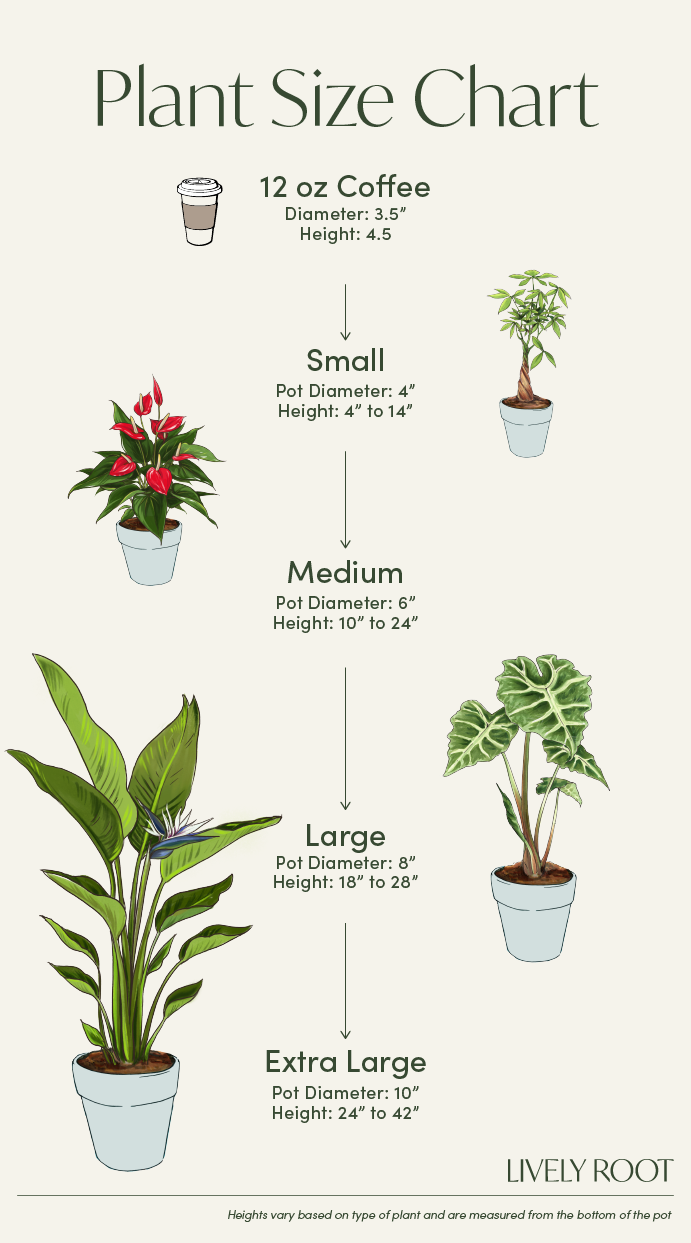

Say hello to the biggest flirt in the Orchid family - the Yellow phalaenopsis Orchid 'Miraflore! The Miraflore Moth Orchid gets your attention with its bright yellow petals and blows you a kiss with its violet-red lips! This gorgeous orchid boasts not one, but TWO stunning flower spikes ensuring it always steals the show. The best part is, these blooms can last up to 3 months!
We ship our orchids in partial bloom, which means you'll see some flowers that haven't entirely opened up yet. The actual color of blooms may vary slightly from what is pictured.
Yellow Moth Orchid ‘Miraflore’ Care & Buying Guide

Phalaenopsis orchids prefer bright, indirect light. Place them near a window where they can receive plenty of indirect sunlight throughout the day. Direct sunlight can burn their leaves, so it's best to filter the light or provide shade during the hottest parts of the day.
Water Phalaenopsis orchids when the potting medium is nearly dry. Typically, this means watering once every 7-10 days, but it can vary depending on factors like temperature, humidity, and potting medium. Ensure thorough watering, allowing excess water to drain out completely to prevent waterlogging.
Phalaenopsis orchids prefer moderate to high humidity levels, ideally between 50-70%. You can increase humidity by placing a tray of water with pebbles beneath the orchid pot, using a humidifier, or grouping orchids together. Avoid placing them near drafts or heating/cooling vents, as these can dry out the air.
Phalaenopsis orchids thrive in temperatures similar to those comfortable for humans. They prefer warmer temperatures during the day, around 75-85°F (24-29°C), and slightly cooler temperatures at night, around 60-65°F (16-18°C). Avoid exposing them to extreme temperature fluctuations.
Your Phalaenopsis orchids will be extra happy if you fertilize every 2-4 weeks during the growing season (spring through early fall) with a balanced orchid fertilizer. Use a diluted fertilizer solution and apply it when watering to avoid over-fertilization, which can damage the roots. Reduce or stop fertilizing during the winter months when growth slows.
Repot Phalaenopsis orchids every 1-2 years or when the potting medium breaks down and becomes soggy. Use a well-draining orchid mix and a pot that allows for good air circulation around the roots. Repotting is best done after flowering when new growth is beginning.
Clean the leaves of Phalaenopsis orchids monthly to remove dust and debris. Use a soft, damp cloth or sponge to gently wipe the leaves, taking care not to damage them. This helps maintain proper leaf function and prevents pests from taking hold.
Yellow Orchid (Miraflore): Overview
The Yellow Phalaenopsis Orchid ‘Miraflore’ (Phalaenopsis spp.) is an elegant plant with glossy green leaves and slender spikes carrying sunny yellow flowers highlighted by a magenta violet center. This flowering plant is a moth orchid, which is one of the most popular orchids grown as houseplants. It belongs to the Orchidaceae family, numbering more than 25,000 species of orchids.
Native to Asia and Australia, this lovely tropical flower is best suited to USDA hardiness zones 10-12 and is most often grown as an indoor plant or a greenhouse plant. The Yellow Moth Orchid grows and blooms best in bright, indirect light, but should be protected from direct sun. Moth Orchid care is straightforward, even for beginners. The Yellow Orchid flowers last for two to three months, giving you plenty of time to enjoy their gorgeous blooms. Phalaenopsis orchids are also non-toxic and safe for pets.
This beautiful plant stands for joy, friendship, and new beginnings, which gives the Yellow Orchid a great symbolic meaning as a gift.
Orchids come in various stunning colors, including the white and pink Red Lip Moth Orchid, the majestic Purple Moth Orchid, and the snowy White Moth Orchid.
How Do You Take Care of a Miraflore Orchid?
Moth orchids are easy to care for. Follow these simple Phalaenopsis Orchid care tips to help your plant thrive.
Watering and Humidity
Water your orchid approximately once every 7-10 days. Hydrate the entire root system, letting excess water drain from the pot before replacing it in its decorative container. Let the soil dry before watering again.
Being tropical plants, Yellow Orchids require higher humidity, ideally from 50% to 70%. To increase indoor humidity, group your plants together, put a pebble tray under the pot, or use a humidifier.
Light and Temperature
Provide a place with bright, indirect sunlight for your Yellow Orchid. An east-facing window is best, ensuring that your orchid gets plenty of morning light but is protected from direct afternoon sun rays. Direct sunlight can scorch this plant’s leaves.
The best temperature for growing orchids is 60°F-85°F, with cooler temperatures at night and warmer temperatures during the day. Avoid placing your orchid in locations with sudden temperature fluctuations or drafts.
Soil and Repotting
For the best Phalaenopsis care, plant your orchid in a well-draining orchid potting mix; add bark to enhance aeration around the roots. Repot your Moth Orchid ‘Miraflore’ approximately every 2 years (after blooming), adding new soil for orchids.
Feeding and Propagation
During the growing season, feed your plant with a balanced fertilizer for orchids. Fertilize only once a month during winter, when the orchid normally goes dormant. Always dilute the fertilizer by half.
The easiest way to propagate your Yellow Phalaenopsis Orchid is via orchid offshoots (called keiki). These offshoots occasionally form on the flower spikes of your orchid, resembling miniature orchid plants. Wait until the keiki develops roots and grows to approximately a third of the parent orchid’s size before separating it. Another method is to divide a mature plant with developed aerial roots.
Common Problems
One of the most common issues orchids suffer from is overwatering, which can lead to root rot if unchecked. Yellowing leaves are a sign that you’re overwatering your orchid.
If your plant isn’t flowering, try moving it to a location with brighter light. Cooler temperatures during the fall can also help the plant develop buds. If your Yellow Moth Orchid develops buds but sheds them before flowering, the reason is usually temperature fluctuations.
Yellow Phalaenopsis Orchid: Placement, Companion & Alternative Plants
The Miraflore Orchid is an elegant plant that adds style and beauty to any living space. If you’ve already fallen in love with this low-maintenance, long-blooming plant, check out our Orchid Subscription for a regular supply of fresh blooms.
Best Locations & Uses
- Great for novice plant enthusiasts because of its easy maintenance
- Perfect gift plant with lasting flowers
- Ideal for homes with cats and dogs, as it’s a pet-friendly plant
- Gorgeous bedroom plant due to its mood-enhancing and air-filtering properties
- A lovely plant for lasting floral arrangements; get several colors with our spectacular Orchid Bundle
Companion Plants
Choose flowering companion plants for your beautiful Phalaenopsis Miraflore orchid to enjoy magnificent flowers throughout the year:
- Blooming Superba Double Begonia (Begonia tuberosa): Boasting fancy double blooms of various bright colors, the Blooming Superba Double Begonia is the perfect plant for hanging baskets or patios, flowering for several months in a row.
- Red Christmas Cactus (Schlumbergera bridgesii 'Red'): The Red Christmas Cactus is a popular holiday plant; its blooming time coincides with Christmas, adding color and good cheer.
- Lipstick Plant (Aeschynanthus radicans): An epiphytic vine with exquisite red flowers that look like tiny lipstick tubes, the Lipstick Plant is sure to add a touch of fun and glamor to your interior.
Alternative Plants
Other amazing plants to enhance your living space’s style include:
- Arcadia Moth Orchid (Phalaenopsis spp.): The sunset-hued, striped flowers of the Arcadia Moth Orchid set it apart from other Phalaenopsis varieties; this lovely moth orchid is an epiphyte that grows on trees and fallen trunks in the wild.
- White Striped Dracaena (Dracaena warneckii): With its shiny, dark green leaves highlighted in white, the White Striped Dracaena develops canes as it grows taller, and turns into a striking small indoor tree.
- Ruby Rubber Tree Plant (Ficus robusta 'Ruby'): Easy-care and known for its air-cleansing qualities, the Ruby Rubber Tree is a charming plant with multicolored foliage that will look great in any living space.
Get a Yellow Moth Orchid From Lively Root Today
Brighten your home’s interior with the sunny Yellow Phalaenopsis Orchid from Lively Root!
























